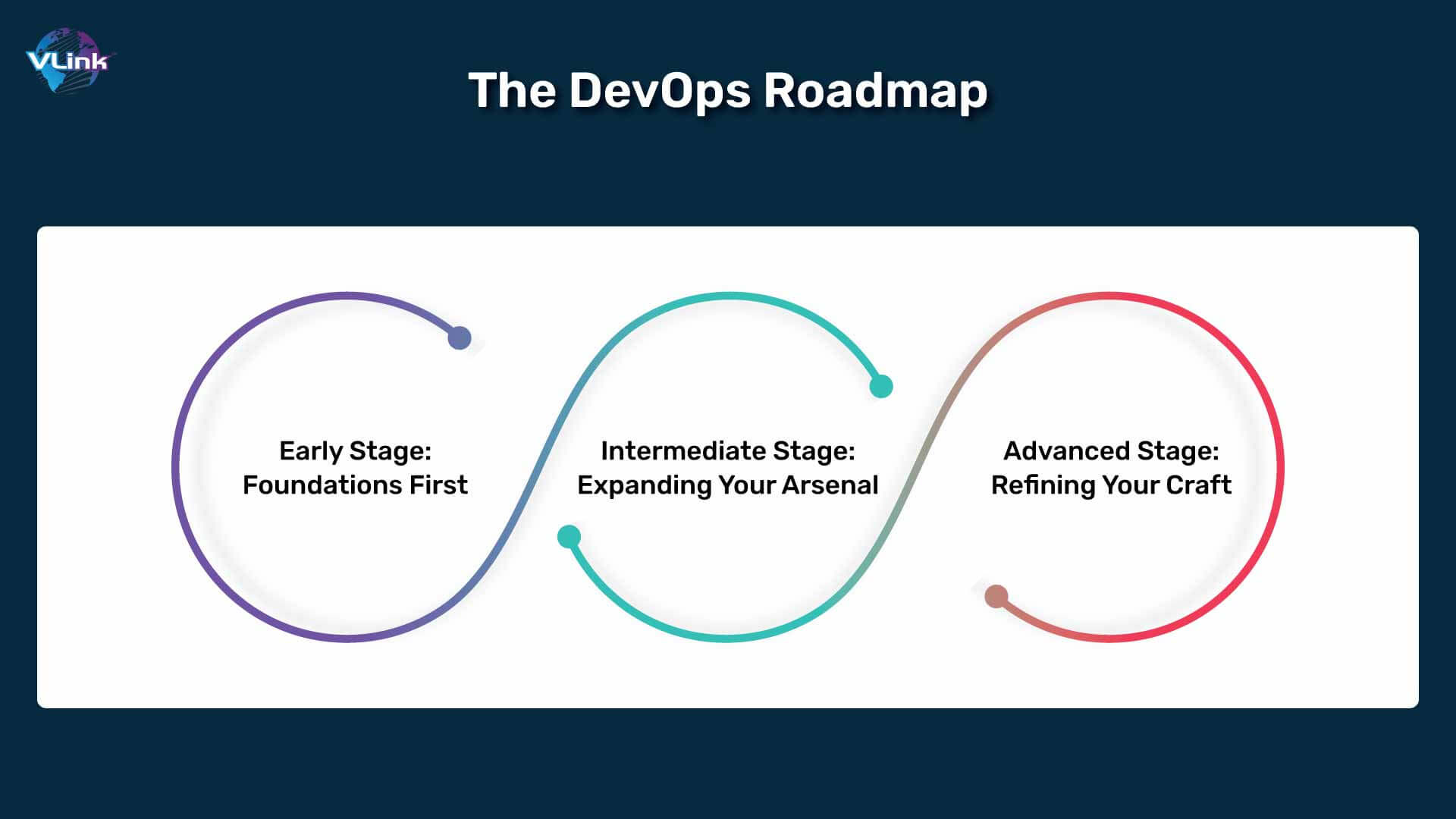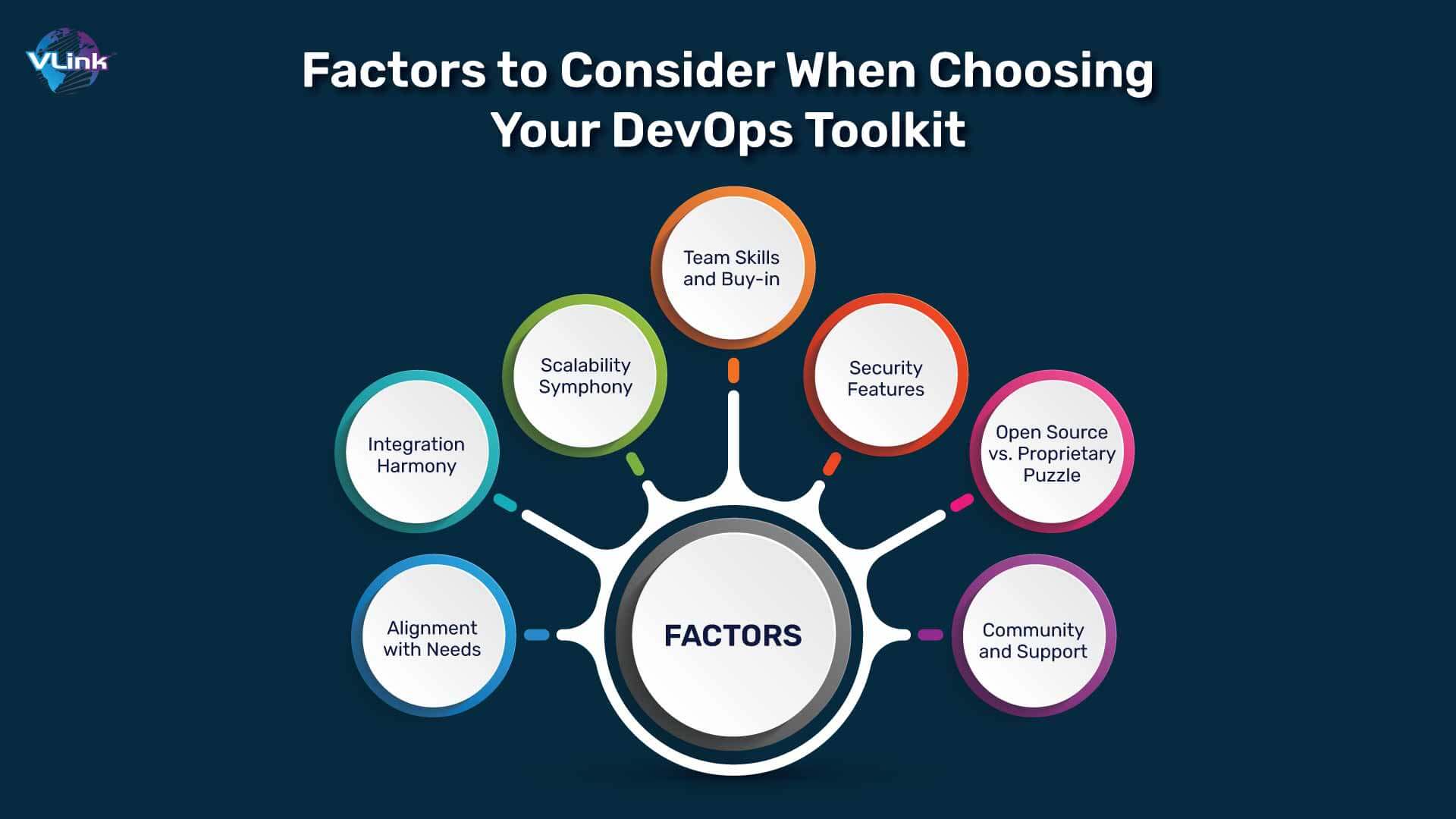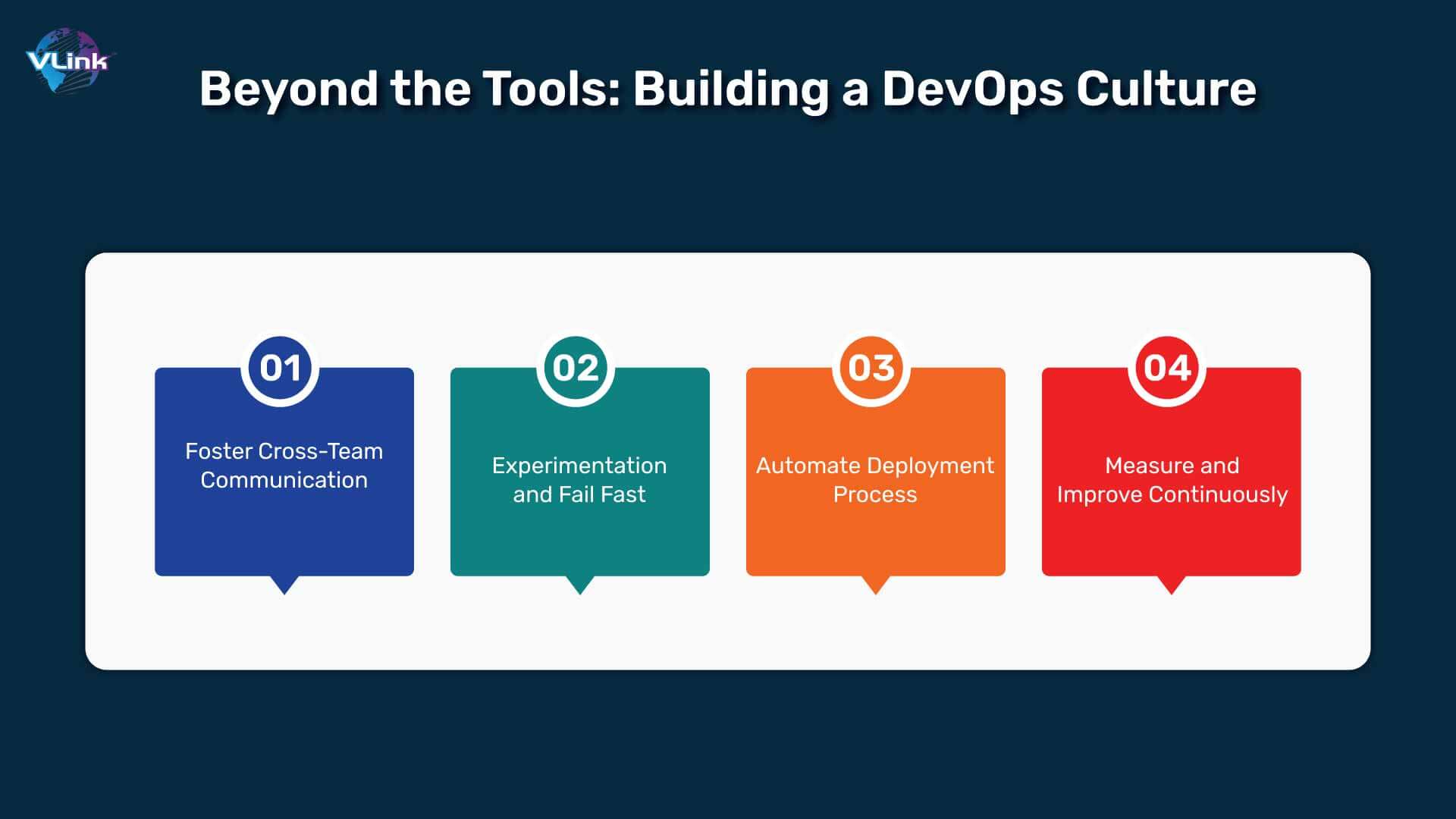Is your software development process stuck in the middle? Longing for rapid releases, lightning-fast bug fixes, and innovation that keeps pace with the tech landscape? Enter DevOps, the secret weapon of modern software heroes. No, this isn't just a buzzword; it's a philosophy that transforms the development-operations gap into a seamless value pipeline.
But wait, isn't adopting DevOps like navigating a labyrinth blindfolded, armed with a shopping cart overflowing with tools? Fear not, fellow developer! Here at VLink, our DevOps engineers are your trusty guides, ready to illuminate the path and help you choose the perfect tools to empower your team.
Are you ready to skip the frustration and go on to the journey of the DevOps revolution? Join us on this exciting journey as we explore the key tools, strategies, and cultural shifts that will transform your software delivery process and turn your team into digital rockstars!
Let’s start!
The DevOps Roadmap
 Before you start throwing tools into your virtual backpack, take a moment to reflect on your current state and desired future. Are you a new DevOps engineer taking your first wobbly steps toward continuous integration? Or are you a seasoned warrior seeking optimization and scalability for your battle-tested pipeline? Recognizing your stage of DevOps maturity will significantly impact your tool choices.
Before you start throwing tools into your virtual backpack, take a moment to reflect on your current state and desired future. Are you a new DevOps engineer taking your first wobbly steps toward continuous integration? Or are you a seasoned warrior seeking optimization and scalability for your battle-tested pipeline? Recognizing your stage of DevOps maturity will significantly impact your tool choices.
Key DevOps Stages and Their Tool Needs:
1. Early Stage: Foundations First
Focus on establishing the essential functionalities that lay the groundwork for your DevOps journey. Think version control with Git, continuous integration with Jenkins or Bamboo, and continuous delivery with tools like Spinnaker or GoCD.
2. Intermediate Stage: Expanding Your Arsenal
Now it's time to graduate from beginner tools and add powerhouses to your arsenal. Configuration management with Ansible or Chef takes control of your infrastructure. Infrastructure as code with Terraform empowers you to define and provision infrastructure like a modern-day architect.
Containerization with Docker and Kubernetes packages your applications like neat little shipping containers, ready for easy deployment and scaling. And remember monitoring tools like Prometheus and Grafana to keep a watchful eye on your system's health.
3. Advanced Stage: Refining Your Craft
For the DevOps veterans, it's time to fine-tune your pipeline with specialized tools. Performance optimization takes center stage with Datadog or Dynatrace, helping you identify and eliminate bottlenecks. Security testing tools like Aqua Security or StackRox become your guardians against the dark forces of vulnerabilities.
And for those who like to embrace chaos (in a controlled way), tools like Gremlin let you inject simulated failures to proactively identify and prevent potential issues.
Read More: Top 10 DevOps Trends To Look For In 2023 & Beyond
Factors to Consider When Choosing Your DevOps Toolkit

Remember, a tool isn't just a pretty name on a list; it's a partner in your DevOps journey. Choose wisely, my friend, by considering these crucial factors:
- Alignment with Needs: Stay blinded by shiny features. Choose tools that solve your pain points and address your current DevOps stage.
- Integration Harmony: Imagine your tools as a rock band; they must play together seamlessly. Open APIs and pre-built integrations are essential for a smooth workflow.
- Scalability Symphony: Your tools should adapt to your ever-changing needs. Can they handle increased workloads and integrate with future technologies? check out.
- Team Skills and Buy-in: Remember, your dedicated team needs to rock these tools, not just download them. Consider their technical expertise and choose user-friendly options with available training and support.
- Security Features: Prioritize tools that offer robust security features and comply with your industry regulations. Remember, even the coolest tool can leave you vulnerable if it's not secure.
- Open Source vs. Proprietary Puzzle: Open-source tools offer flexibility and cost-effectiveness, while proprietary ones often provide additional support and features. Choose based on your budget and specific needs.
- Community and Support: A vibrant community and readily available support resources can be your saving grace when you encounter bumps on the road.
Popular DevOps Tools and Their Roles
Here's a quick glimpse into some popular tools across different DevOps stages to get you started:
Infrastructure as Code (IaC):
- Terraform
- AWS CloudFormation
- AWS CDK
- Azure Resource Manager
- Azure Bicep
- Azure PowerShell
Version Control Systems (VCS):
- Azure Repos
- GitHub
- GitLab
- Bitbucket
Continuous Integration/Continuous Delivery (CI/CD):
- Jenkins
- GitHub Actions
- Azure Pipeline
- AWS CodeCommiT
- AWS CodePipeline
Containerization:
- Docker
- Kubernetes
Configuration Management:
- Ansible
- SaltStack
- Chef
- Puppet
Performance Monitoring:
- Prometheus
- Grafana
- Datadog
- New Relic
Cloud Providers:
- AWS
- Azure
- GCP
Security & Compliance:
- Aqua Security
- Qualys
- Prisma Cloud
- AWS Security Hub
- Azure Security Center
Logging & Analytics:
- ELK Stack
- Splunk
- Sumo Logic
Communication & Collaboration:
- Slack
- Microsoft Teams
- Jira
Note: This is just a taste of the vast DevOps tool landscape, and the best choices for you will depend on your unique needs and preferences.
Read More: DevOps: A New Pillar of Successful Healthcare Insurance Practices & Why Today’s Manufacturing Industry Needs DevOps
Beyond the Tools: Building a DevOps Culture

Well, imagine each team as a separate instrument, playing their tune independently of the others. The music might be technically correct, but it lacks soul, coherence, and that electrifying power that comes from true collaboration. That's what happens when development and operations teams work in silos. DevOps breaks down these silos, encouraging a shared ownership mentality and open communication.
Here's how you can cultivate this collaborative culture:
Foster Cross-Team Communication:
Break down the walls between online and offline teams. Encourage regular meetings, knowledge-sharing sessions, and joint problem-solving workshops. Remember, communication is the oil that keeps the DevOps engine running smoothly.
Experimentation and Fail Fast:
Be bold and try new tools, methodologies, and processes. Experimentation is the lifeblood of DevOps, allowing you to learn, adapt, and constantly improve. Remember, even failed experiments offer valuable lessons.
Automate Deployment Process:
Let the machines handle the repetitive tasks! Automate deployment processes, infrastructure provisioning, and testing to free up your team's time for more strategic initiatives. Focus on building automation pipelines that are modular, repeatable, and easy to maintain.
Measure and Improve Continuously:
DevOps is a journey, not a destination. Regularly track key metrics like lead time, deployment frequency, and defect rate to identify areas for improvement. Use data-driven insights to refine your processes and tools, ensuring continuous evolution and progress.
Note:- Building a strong DevOps culture takes time and effort, but the rewards are plentiful. You can reap some benefits of increased collaboration, faster releases, improved quality, and happier teams.
Explore More: How Netflix Utilized Devops to Level Up?
Wrapping Up: Continuous Learning & Evolution
The world of DevOps is constantly evolving, with new tools and technologies emerging at breakneck speed. To stay ahead of the curve, embrace continuous learning as your mantra. Regularly explore new tools, attend industry conferences, and participate in online communities. Remember, the more you learn, the better equipped you'll be to navigate the ever-changing DevOps landscape and keep your team playing the sweet melody of success.
So, dear developer, confidently choose your DevOps journey, choose your tools wisely, and build a strong collaborative culture. With the right mindset and tools, you can transform your software delivery process into a symphony of agility, efficiency, and innovation.
Frequently Asked Questions
Costs vary depending on your chosen tools, their licensing models (open-source vs. proprietary), and any required infrastructure changes. Open-source tools offer lower upfront costs, while proprietary ones often provide additional features and support.
While tools can accelerate and streamline your DevOps journey, starting with manual processes and basic scripts is possible. However, as your DevOps practices mature and your needs evolve, tools become increasingly important for automation, scalability, and efficiency. Consider starting with open-source or free trials to explore and evaluate before committing to larger investments.
Regularly evaluate your toolset to ensure it aligns with your evolving needs and takes advantage of new technologies. Industry best practices recommend reviewing your tools at least annually but consider doing it more frequently depending on the pace of change in your organization and the DevOps landscape. Stay informed about tool advancements and features that can further optimize your pipeline.








